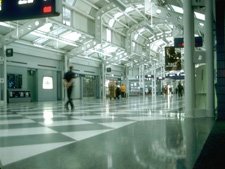Checkpoint Evolution Up and Running at BWI: Even More Changes Announced to Reduce Hassle to Passengers
 In February, Secretary Chertoff told an editorial board that he had directed TSA to do a sixty-day, no-holds-barred review of what we do at the passenger checkpoint to see if we can weed out things that used to be needed but perhaps today could be stream-lined. This effort ties in with our longer term effort to update our security measures -- to go on offense rather than just wait behind the magnetometer and try to find prohibited items. Today at Baltimore-Washington International Thurgood Marshall Airport (BWI), those efforts come together. And, starting today, they become reality.
In February, Secretary Chertoff told an editorial board that he had directed TSA to do a sixty-day, no-holds-barred review of what we do at the passenger checkpoint to see if we can weed out things that used to be needed but perhaps today could be stream-lined. This effort ties in with our longer term effort to update our security measures -- to go on offense rather than just wait behind the magnetometer and try to find prohibited items. Today at Baltimore-Washington International Thurgood Marshall Airport (BWI), those efforts come together. And, starting today, they become reality.Here are the ‘greatest hits’ that are in the works:
Airlines may now allow kiosk/at-home printing of boarding passes for almost everyone. Secretary Chertoff challenged TSA to reduce the hassle thousands of passengers have every day when they can’t print a boarding pass online or at an airline kiosk. They have problems not because they pose a threat to aviation, but because their names are the same or similar to someone whose name is really on a watch list and does pose a threat.
Think of it this way: for every actual person on the watch list, there are thousands of people – who don’t pose a threat – but whose name is close enough that they are flagged in the system and not allowed to print their boarding pass. These passengers must go to the ticket counter to resolve the issue by showing photo identification, and it’s a huge inconvenience to them. Many of these ordinary travelers feel that they have been watch-listed, which would make anyone mad.

TSA has asked airlines to create a secure system to accept passengers’ dates of birth, first at the ticket counter and subsequently in their frequent flier or other secure database. Passengers will be encouraged, but not required, to provide airlines with limited identifying information like their date of birth. If they do so once, the airline can clear them on future flights and they will be able to print their boarding passes at home or at the kiosk.
Better ID verification.
A key to an accurate watch-list process is making sure that people are who they say they are. TSA officers already are using more sophisticated methods to validate a traveler’s identity. In addition, TSA is today outlining the types of ID that will get you through security faster. Essentially, driver’s licenses with photos and passports are what we are looking for. If you left your wallet in a cab, or for some reason do not have the right ID, we will work with you, but it will take longer.
Make the physical layout work for us.
BWI’s “B” Checkpoint has a different look today – it’s the first place to rollout the Checkpoint Evolution elements. We’ve integrated all the elements to work together and get us a calmer checkpoint environment that benefits our active security measures like behavior observation. Easier divesting and bin loading, better light and less noise are examples of things that help security and also lessen hassle for passengers.
We’re excited about these initiatives, because they will improve the passenger’s experience with TSA, but more importantly, they will help our security officers carry out their critical mission. If you fly through BWI, be sure to come back to the blog and let us know what you think.
Click here for more information.
Kip Hawley
Labels: innovation, mission











